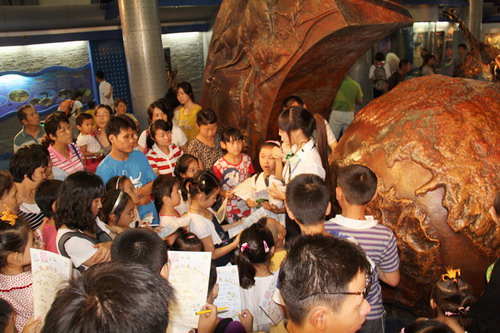News
A Joyous Search for the Most Extraordinary
published:2011-08-19
As a celebratory act at the beginning of the summer holiday, BMNH launched the ‘A Joyous Search for the Most Extraordinary’ activity, the first session of BMNH’s Thematic Explanation Project, which would help the visitors tour around the galleries and gain a better understanding of the exhibits. The visitors followed the docents to see some galleries and tried to spot the ‘most extraordinary exhibits’ in the museum at the same time.
At the beginning, the docents handed out especially designed worksheets to the visitors. On the worksheets, the route and the intriguing quiz were given. Then the search started with the enthusiastic expectancy of the visitors.
The search journey was composed of four stops, including the Hall of Ancient Reptiles, the Hall of Ancient Mammals, the Hall of Plant Evolution and Sceneries as well as the Hall of the Beauty of Animals. In each hall, special tags denoting the extraordinary exhibits were deliberately hidden. When the visitors detected the tags, the docents would provide detailed information about the particular exhibits. The participants felt really engaged in the search and listened with intensive attention to the explanation.
A short break was given in the middle of the activity at the rest area on the second floor. During the break, a little game attracted the visitors. They were asked to sit in a line and, with the help of the docents, passed some pieces of information to the one sitting next to them. They were so vehement that even the visitors not participating in the game were impacted and followed the process with great interest. The traditional game showed the importance of sharing information in knowledge acquisition.
When the activity drew to an end, the participants were reluctant to accept its termination. Most participants were able to answer the quiz correctly on the worksheets since they had been actively involved in the activity, and each were awarded a certificate for their excellent performance in the program. The participants were very excited by the knowledge they gained in the process and they said it would be great to explore the outside real wild and see the natural world with their own eyes.
The thematic guidance activity made the participants’ visit to the galleries more efficient and more interesting. They were able to interact with the docents and with their fellows. They could concentrate on learning about the exhibits and rid themselves of the confusion about what route they should follow when visiting the galleries.


